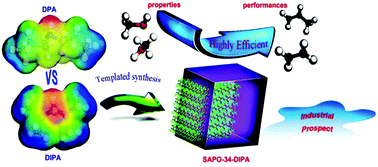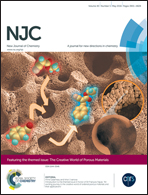SAPO-34 templated by dipropylamine and diisopropylamine: synthesis and catalytic performance in the methanol to olefin (MTO) reaction†
Abstract
In this work, a comprehensive study of the hydrothermal synthesis and catalytic performance of SAPO-34 templated by the isomeric dipropylamine (DPA) and diisopropylamine (DIPA) was carried out. SAPO-34 with a faster crystallization rate and lower Si content could be obtained with DIPA as the template, suggesting the better templating efficacy of DIPA than DPA. Theoretical calculations reveal that DIPA possesses more favourable non-bonding interactions with the CHA framework and the electronic configuration is of vital importance in determining the template efficacy. SAPO-34-DIPA with low silicon contents exhibits excellent performance, over which a maximum selectivity of ethylene plus propylene (87.2%) is observed. This value should be among the top ever reported. The surface Si enrichment on the crystals, which is both template- and condition-dependent, is revealed to be of significant influence in the catalytic performance. The relatively homogenous Si distribution in the crystals, lower acid concentration and weaker acid strength corporately make SAPO-34-DIPA an excellent MTO catalyst.

- This article is part of the themed collection: The Creative World of Porous Materials

 Please wait while we load your content...
Please wait while we load your content...